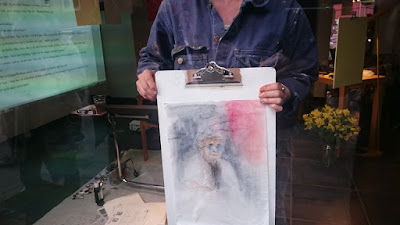In an earlier post I wrote about translating a chapter from Killing Commendatore, in which Boku finds an old painting in the attic. I wrote about how after reaching on the internet for different ways people imagined the painting helped mi visualize it and write (or: translate) about it.
I went through a similar process when translating Chapter 16. In that chapter Boku, a professional portrait painter, is working on a portrait of Menshiki (whom I also tried to imagine with internet's help). The process starts from sketching Menshiki, who poses for his portrait. But later the painter continues painting from memory and allowing his subconscious to take over and for the inspiration for colors and textures to emerge from within. He describes adding thick black lines to create a "skeleton" of the portrait, and later adds white, green and orange. Gradually Menshiki's face becomes invisible but Menshiki is still present in the painting. This is perhaps a bit of a spoiler, but let me just say that Menshiki really likes the resulting portrait.
I tried to imagine what the portrait might have looked like and then remembered that the webpage where I have found different versions of Killing Commendatore painting also provided somebody's visualization of different stages of the portrait's creation. Here are the images, which you can find at:
painginghttps://komyushou.com/mennshiki-wataru



I went through a similar process when translating Chapter 16. In that chapter Boku, a professional portrait painter, is working on a portrait of Menshiki (whom I also tried to imagine with internet's help). The process starts from sketching Menshiki, who poses for his portrait. But later the painter continues painting from memory and allowing his subconscious to take over and for the inspiration for colors and textures to emerge from within. He describes adding thick black lines to create a "skeleton" of the portrait, and later adds white, green and orange. Gradually Menshiki's face becomes invisible but Menshiki is still present in the painting. This is perhaps a bit of a spoiler, but let me just say that Menshiki really likes the resulting portrait.
I tried to imagine what the portrait might have looked like and then remembered that the webpage where I have found different versions of Killing Commendatore painting also provided somebody's visualization of different stages of the portrait's creation. Here are the images, which you can find at:
painginghttps://komyushou.com/mennshiki-wataru



















































